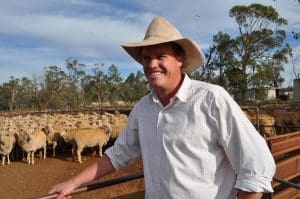
Merino genetics consultant Craig Wilson.
MERINO breeders can compare the efficiency and profit variability of 77 bloodlines in a ten-year study of wether trials released this week.
The 2006-2016 Merino Bloodline Performance report includes a new measure for bloodline standard deviation of profit ($/DSE), indicating the amount of variation around the average profit per DSE.
The report also includes a measure for each bloodline’s standard deviation of profit ($/hd) per hectare, indicating the amount of variation around the average profit per head. A larger standard deviation indicates greater variation in profit.
NSW-based Merino genetics consultant Craig Wilson said the report was a good place to start for producers looking to lift profitability.
Significant differences in Merino bloodline profitability have been highlighted in the report. About 25 percent of the teams in the 10-year data have come out of wether trials run by Craig Wilson and Associates. For the 2016 analysis, GrassGro™ was used to calculate the financial performance of each bloodline.
Mr Wilson said the report’s objective and peer-reviewed information will give the industry some clarity.
“Producers should have a rally high level of confidence in the accuracy of the data – it is very much objective information without the spin that tends to be handed about.”
Mr Wilson said obviously there were factors apart from wool returns that were involved in profitably running Merinos, “but genetics is probably a good place to start.”
He said it was important to be aware that participating studs were prepared to benchmark their product and have done well against other top breeders.
“There are obviously a number of studs in the industry that haven’t got information there.”
But Mr Wilson said the information in the report should be viewed in the context of individual breeder objectives.
Wether data can be used to finetune breeding programs
New South Wales’ Department of Primary Industries said the report has delivered crucial information to stud breeders with noteworthy implications for the future profitability and performance of 77 Merino bloodlines.
NSW DPI research scientist, Sue Hatcher, said Merino breeders can now use the information to identify the relative performance of bloodlines and fine-tune their breeding programs.
“Genetic data from a 10-year study of wether trials run across Australia shows a significant variation in production between bloodlines,” Dr Hatcher said.
“In our analysis of 25 wether trials in NSW, Victoria and Tasmania, and one ewe productivity trial in Western Australia, we saw bloodlines vary across a range of 3.5 microns in fibre diameter, 20pc in clean fleece and 23pc in live weight.
“These production differences translate into very significant differences in bloodline profitability,” she said.
“A finer bloodline can be chosen to reduce fibre diameter without compromising fleece weight or a bloodline with heavier clean fleece weight can be chosen while maintaining the current fibre diameter.”
Important determinants of Merino profitability, 11 traits and two measures of financial performance, are given in the report and bloodlines can be compared on the profit per head or profit per dry sheep equivalent (DSE).
Dr Hatcher said Merino producers can confidently use the data from Merino Bloodline Performance to assist in selecting bloodlines that best suit their breeding objectives.
“The information gives a very reliable indication of potential profitability from the bloodlines,” she said.
“Each trial has run for two to four years, ensuring high accuracy in the data collected.
Genetic data has been isolated from seasonal and geographic environmental differences by grouping multiple bloodlines into teams of wethers across the trial sites.
The NSW wether trials were conducted in the Riverina, Central Tablelands, Central West, Northern Tablelands, Southern Tablelands and the Monaro.
Australian Wool Innovation (AWI) and DPI funded the Merino Bloodline Performance project, with a new three-year AWI Strategic Plan committed to lifting Merino reproductive performance and profitability.
Click here to read a NSW DPI primefact version of the report.
More information and copies of the report are available online, www.merinobloodlines.com.au
Source: NSW DPI.



HAVE YOUR SAY